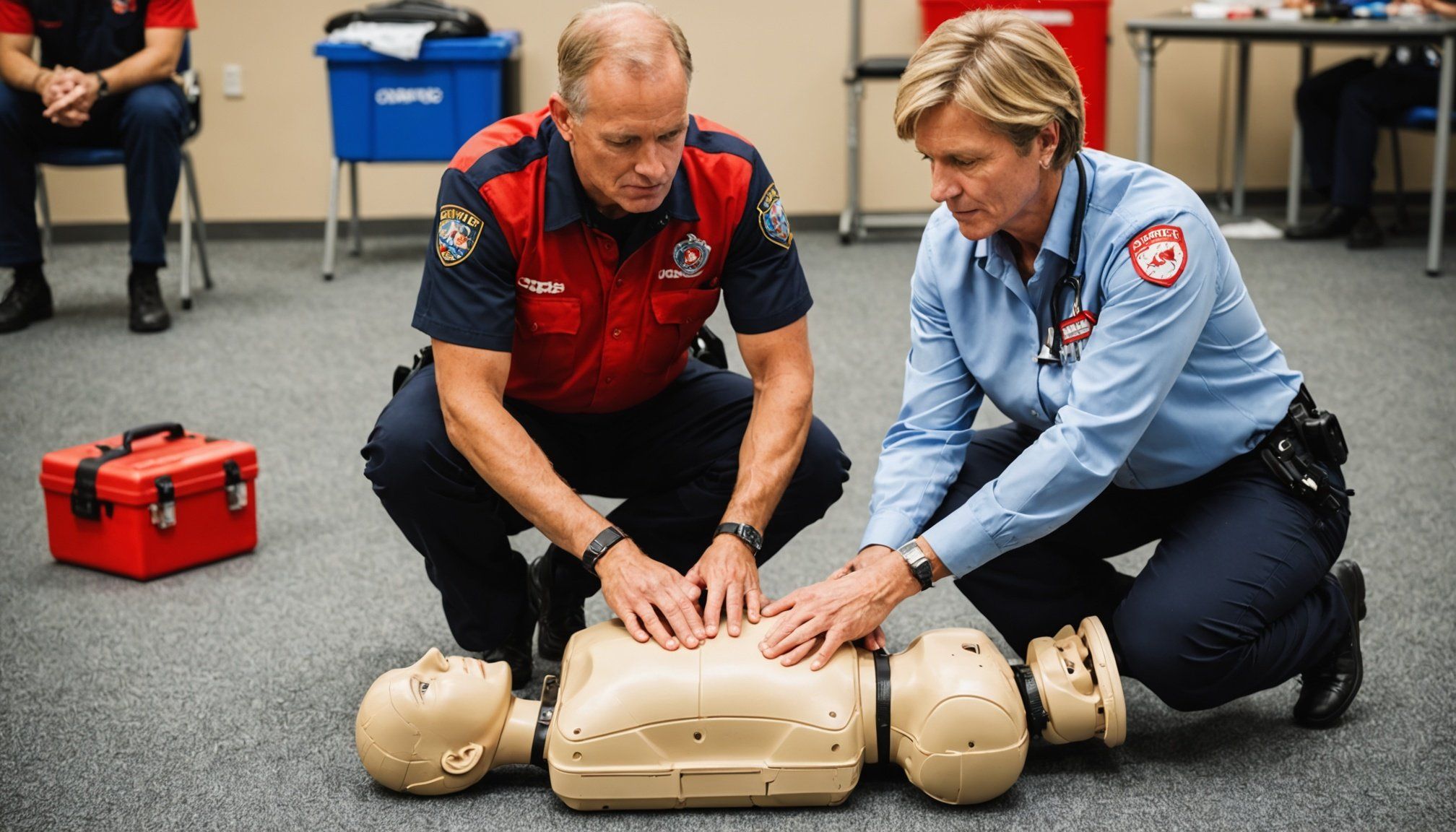Understanding Hands-Only CPR
Hands-Only CPR is a crucial skill that can save lives during cardiac emergencies. It emphasizes chest compressions without mouth-to-mouth resuscitation. Key statistics reveal that bystander intervention using Hands-Only CPR doubles or triples survival rates. Imagine witnessing someone collapse; immediate, confident action can be the difference between life and death.
Definition and Importance
The essence of Hands-Only CPR lies in its simplicity and accessibility. Unlike traditional CPR, it does not require specialized training or certification, making it more feasible for the general public to learn and perform. The focus on continuous chest compressions keeps the blood circulating, supplying vital organs with oxygen.
Also to discover : Pawsitive Connections: How Pet-Assisted Therapy Enhances Social Skills in Children with Autism
Physiological Benefits
During a cardiac event, blood flow ceases, depriving the heart and brain of oxygen. Hands-Only CPR’s rhythmic compressions help maintain oxygenated blood flow, delaying tissue damage and increasing the chances of a successful defibrillation. It’s a practical, immediate response when seconds count.
By understanding the effectiveness and physiological benefits of CPR, individuals can act swiftly in emergencies, potentially saving lives. Encouraging more people to learn Hands-Only CPR increases community readiness, reinforcing the importance of prompt assistance during cardiac emergencies.
Also to see : Optimized Nutrition Strategies: Boosting Endurance Athletes’ Performance with Precision Diets
Essential Teaching Techniques
Engaging adult learners in CPR training requires effective teaching techniques. Active learning methods, like engaging learners in discussions and hands-on activities, foster better retention and understanding. Utilizing the demonstration-practice-feedback model is crucial. This approach involves showing the correct execution first, allowing participants to practice, and then providing feedback to reinforce proper techniques.
Creating a supportive learning atmosphere is equally important. Adult learners benefit from environments where they feel comfortable asking questions and making mistakes. Establishing a collaborative setting encourages learners to actively participate and trust the training process.
Instructors can further enhance engagement by using varied instructional strategies. Incorporating multimedia tools, such as videos that demonstrate CPR scenarios, can help clarify complex concepts. Engaging learners through role-playing can simulate real-life situations, enabling them to apply skills in a practical context.
By focusing on these instructional strategies, CPR trainers can effectively teach essential life-saving skills. Tailoring methods to fit the needs and preferences of adult learners ensures not only proficiency in CPR but also the confidence to act in emergency situations.
Step-by-Step Instructions for Hands-Only CPR
Teaching Hands-Only CPR effectively relies on clear, structured instructions. These steps enhance understanding and skill retention.
Preparing to Teach
Begin by gathering necessary equipment, such as dummies and visual aids, to provide a realistic training experience. Create an optimal learning environment free from distractions, conducive to focus and interaction. Clearly establish learner objectives, ensuring all participants understand the session’s goals.
Demonstrating the Technique
Show how to position hands correctly at the centre of the chest, one hand over the other. Emphasize compressing at least 5 cm deep and at a rate of 100-120 compressions per minute. Coupling this with vocal instruction ensures learners grasp each component accurately.
Allowing Practice
Facilitate practice by guiding learners through sessions where they apply techniques independently. Encourage peer feedback, promoting collaborative learning and confidence. Address common errors and misconceptions on-the-spot to foster continuous improvement.
Utilizing these detailed, structured approaches allows CPR instructors to effectively impart life-saving skills, equipping learners to respond confidently in emergencies.
Engaging Activities for Learners
Introducing interactive learning experiences during CPR training significantly enhances retention and confidence. CPR practice activities, such as simulation and role-playing scenarios, immerse learners in real-life situations. This approach enables them to apply their skills in a controlled setting, fostering quick decision-making and adaptability.
Utilizing multimedia tools can effectively illustrate key CPR concepts. Videos showing various cardiac emergency scenarios help learners visualize the practical application of skills and reinforce theoretical knowledge. These resources break down complex processes into understandable segments, catering to diverse learning preferences.
Incorporating group competitions serves as a dynamic method to reinforce skills. By fostering a competitive yet supportive atmosphere, participants are motivated to improve their techniques. Such activities not only strengthen skills but also build camaraderie among learners.
Another engaging strategy involves inviting participants to track their progress. This personal accountability encourages dedication to mastering CPR skills. Allowing for varied and engaging activities ensures a comprehensive training experience, equipping learners with the confidence to perform Hands-Only CPR effectively in emergencies.
Assessing Learner Understanding
Effectively evaluating comprehension is vital in CPR training and involves several assessment techniques. Begin by designing cohesive knowledge checks to ensure each participant understands key CPR concepts. Structured quizzes and scenario-based questions can serve this purpose. Measuring skills through practical evaluations, where learners perform CPR on dummies, adds a hands-on dimension to the assessment.
Providing constructive feedback boosts learner confidence and skill improvement. Clear, actionable comments following assessments help individuals and groups know their strengths and where they need enhancement. Emphasizing positive reinforcement encourages continued learning and skill retention.
To monitor ongoing progress, establish a system to track learner improvements over multiple sessions. Offer opportunities for learners to reflect on their performance, encouraging self-assessment and setting personal goals. Creating a feedback loop not only enhances understanding but also fosters a supportive learning environment.
Implementing these evaluation methods supports robust CPR education by ensuring learners can confidently execute lifesaving techniques in real emergencies. Regular assessment maintains engagement and identifies areas requiring additional attention, paving the path for continual learner development in CPR proficiency.
Addressing Challenges in Teaching
Teaching CPR, especially to beginners, involves navigating common teaching challenges. Learners often face anxiety or resistance to participating. Techniques for recognizing and addressing these feelings involve using reassurance and framing CPR as a skill anyone can master. Encouraging questions and creating a non-judgmental atmosphere can alleviate fears.
Adapting methods to cater to diverse learning styles is crucial. Visual learners may benefit from demonstrations and videos, auditory learners from verbal instructions, and hands-on learners from practice sessions. Combining these strategies ensures comprehensive understanding and engagement.
Managing group dynamics during training can pose challenges, especially if individuals dominate discussions or hesitate to participate. Solutions for CPR education include setting clear guidelines for interaction and encouraging every learner to contribute. Creating smaller groups for discussion can enable quieter participants to express themselves.
Another challenge is maintaining learner focus and motivation. Implementing troubleshooting strategies, like incorporating engaging activities and regular breaks, can keep learners energized. By understanding and addressing these challenges, instructors can create an inclusive and supportive environment, enhancing the learning experience and proficiency in performing Hands-Only CPR.
Resources for CPR Instructors
CPR instructors have a wealth of resources at their disposal to elevate the quality of their training sessions. Recommended manuals and online courses provide comprehensive guidelines and cutting-edge techniques necessary for effective instruction. These materials ensure instructors are well-prepared to convey both theoretical and practical CPR skills to their learners.
Accessing community resources and partnerships can significantly expand instructional capabilities. Local emergency services and health organizations often offer support and additional training, fostering a collaborative approach to community health education. Engaging with these entities leads to a better understanding of real-world application, enhancing the teaching experience.
Staying current with CPR guidelines and best practices is essential for delivering up-to-date and accurate training. Regularly reviewing updates from authoritative bodies like the American Heart Association ensures instructors offer the most effective and evidence-based training methods. Incorporating these updates into lesson plans ensures learners receive the most relevant instruction.
By utilizing these valuable resources, CPR instructors can maintain high teaching standards, foster learner engagement, and ultimately contribute to more competent and confident CPR providers in the community.





